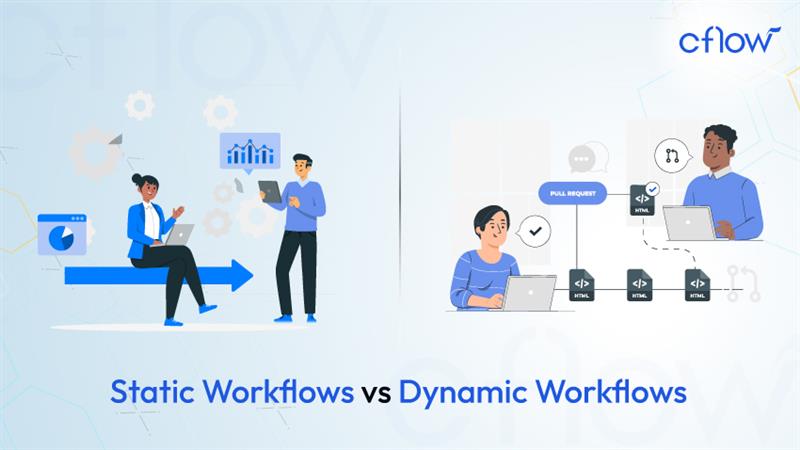Static vs Dynamic Workflows – How Automation using Cflow Helps?

Key takeaways
- Workflow in a general sense defines and sequentially executes a set of functions or methods, which are called the stages in the process.
- The business environment can be unpredictable and unprecedented, hence, the process workflows need to be flexible and adaptable to the changing scenarios.
- The business operation workflows can be categorized into static and dynamic workflow automation, where static workflow automation is a fixed and sequential workflow, and dynamic workflow automation can adapt to changing demands.
- Static and dynamic workflow automation on Cflow is simplified with predefined rules set in the rules engine.
Workflow in a general sense defines and sequentially executes a set of functions or methods, which are called the stages in the process. Working sequentially offers a flow to the business operations. In today’s business scenario, organizations prefer to automate multiple workflows where only the first step has to be initiated by the human, which further moves into other steps done by the system. However, business scenarios can be unpredictable, and sometimes the set sequential setup has to be changed.
This is where a dynamic workflow becomes absolutely necessary. Business process workflow can be categorized based on their adaptability. Workflows can be static and dynamic. Let us see what they mean and how they differ in detail.
Table of Contents
Static Workflow Automation
Static workflow is a type of automated workflow where the tasks within the processes are aligned in a pre-defined order. This type of automated workflow is generally used for simple tasks that are repetitive and performed routinely. In static workflows, the sequence often remains rigid and does not involve any significant decision-making steps. This type of automated workflow comes in handy when dealing with cost control, and reduction in the processing time of routine tasks.
Examples where Static Workflows are Used –
- Leave Workflow – Leave workflow has a steady and fixed sequential process flow. This is one of the most common workflows used, where employees can request time off from work.
- System Backup Workflow – Regular system backup is one common process that has fixed stages in the process.
- Refund Workflows – The reimbursement process is a process through which the amount spent by employees for work-related expenses is refunded.
Dynamic Workflow Automation
On the other hand dynamic workflows serve a different purpose. These are business workflows that can change or adapt to the changing circumstances in the business environment. As the working environment is prone to constantly changing needs, it is essential to have processes that are flexible to change its trajectory. Dynamic workflows do that for you. This type of workflow is specifically designed for complex tasks that involve decision-making capabilities. This enables the workflow to adapt according to the changing business conditions or requirements.
Examples where Static Workflows are Used –
- Modifying Code Logic – Using a dynamic workflow, the code logic can be modified at runtime.
- Recursion – Dynamic workflows are best suited for achieving recursion. A merge can be introduced using a dynamic workflow.
- Shipping – Dynamic workflows are best in the case of the couriers being shipped based on the different shipping addresses.
Dynamic Vs Static Workflows
| Pros | Cons | |
|---|---|---|
| Static |
|
|
Dynamic |
|
|
End-to-end workflow automation
Build fully-customizable, no code process workflows in a jiffy.
Automating Static and Dynamic Workflows with Cflow
Cflow is a simple AI-based workflow automation platform offering extensive features for optimizing any business process. With a simple user interface, Cflow is one of the most user-friendly platforms and is best suited for small, medium, and enterprise organizations. Workflows can be built or generated using AI, with just the drag-and-drop action.
Static and dynamic workflow automation on Cflow is simplified with predefined rules set in the rules engine. These predefined rules navigate the process from one stage to the next, making it a continuous and uninterrupted process. The robust routing and notification system enhances the change in the dynamic workflow and alerts all the participating users.
Why should you Automate Processes with Cflow?
- Workflow flexibility
- Reduces workflow maintenance
- Quickly adapt to changing circumstances
- Create and execute cross-enterprise functionalities
Case Study – Workflow Flexibility for SnF Management Company with Dynamic Workflow
SnF Management Company is a worldwide known business for its service of professional and skilled nursing and rehabilitation centers under the name Windsor. The company handled piles of CapEx projects and demanded a fast-paced approval process. This led to the process being slow and delayed. The manually done process lacked visibility into the status of each request, failing to give the requesters any update.
As a no-node workflow automation platform, Cflow was able to streamline the different tasks within CapEx by setting up a dynamic workflow for CapEx Approval that transformed its pace. The process automation also enhanced customer support. SnF Management Company ultimately eliminated all inefficiencies in the CapEx process with Cflow’s all-powerful automation support.
Conclusion
The constant change in the business dynamics can be unpredictable and frustrating. Static workflows enhance the efficiency of processes with automatic navigation, however, they cannot adapt to changing needs. This is where a dynamic workflow is a game-changer. Dynamic workflows can be set using advanced setup features such as parallel stages, and workflow loops, that enable reverting the requests to any stage.
Cflow is a platform that can be leveraged to build effective dynamic and static workflows that fit the needs of an organization. Sign up now.
What should you do next?
Thanks for reading till the end. Here are 3 ways we can help you automate your business:

Do better workflow automation with Cflow
Create workflows with multiple steps, parallel reviewals. auto approvals, public forms, etc. to save time and cost.

Talk to a workflow expert
Get a 30-min. free consultation with our Workflow expert to optimize your daily tasks.

Get smarter with our workflow resources
Explore our workflow automation blogs, ebooks, and other resources to master workflow automation.

